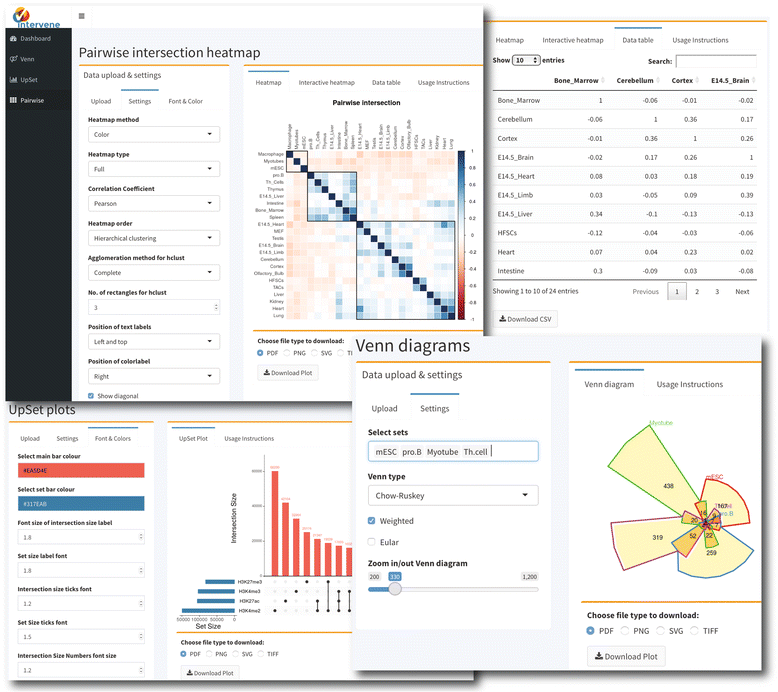Difference between revisions of "Template:Article of the week"
Shawndouglas (talk | contribs) (Updated article of the week text.) |
Shawndouglas (talk | contribs) (Updated article of the week text.) |
||
| Line 1: | Line 1: | ||
<div style="float: left; margin: 0.5em 0.9em 0.4em 0em;">[[File: | <div style="float: left; margin: 0.5em 0.9em 0.4em 0em;">[[File:Fig3 Khan BMCBioinformatics2017 18.gif|240px]]</div> | ||
'''"[[Journal: | '''"[[Journal:Intervene: A tool for intersection and visualization of multiple gene or genomic region sets|Intervene: A tool for intersection and visualization of multiple gene or genomic region sets]]"''' | ||
A common task for scientists relies on comparing lists of genes or genomic regions derived from high-throughput sequencing experiments. While several tools exist to intersect and visualize sets of genes, similar tools dedicated to the visualization of genomic region sets are currently limited. | |||
To address this gap, we have developed the Intervene tool, which provides an easy and automated interface for the effective intersection and visualization of genomic region or list sets, thus facilitating their analysis and interpretation. Intervene contains three modules: ''venn'' to generate Venn diagrams of up to six sets, ''upset'' to generate UpSet plots of multiple sets, and ''pairwise'' to compute and visualize intersections of multiple sets as clustered heat maps. Intervene, and its interactive web ShinyApp companion, generate publication-quality figures for the interpretation of genomic region and list sets. ('''[[Journal:Intervene: A tool for intersection and visualization of multiple gene or genomic region sets|Full article...]]''')<br /> | |||
<br /> | <br /> | ||
''Recently featured'': | ''Recently featured'': | ||
: ▪ [[Journal:Users’ perspectives on a picture archiving and communication system (PACS): An in-depth study in a teaching hospital in Kuwait|Users’ perspectives on a picture archiving and communication system (PACS): An in-depth study in a teaching hospital in Kuwait]] | |||
: ▪ [[Journal:Effective information extraction framework for heterogeneous clinical reports using online machine learning and controlled vocabularies|Effective information extraction framework for heterogeneous clinical reports using online machine learning and controlled vocabularies]] | : ▪ [[Journal:Effective information extraction framework for heterogeneous clinical reports using online machine learning and controlled vocabularies|Effective information extraction framework for heterogeneous clinical reports using online machine learning and controlled vocabularies]] | ||
: ▪ [[Journal:Selecting a laboratory information management system for biorepositories in low- and middle-income countries: The H3Africa experience and lessons learned|Selecting a laboratory information management system for biorepositories in low- and middle-income countries: The H3Africa experience and lessons learned]] | : ▪ [[Journal:Selecting a laboratory information management system for biorepositories in low- and middle-income countries: The H3Africa experience and lessons learned|Selecting a laboratory information management system for biorepositories in low- and middle-income countries: The H3Africa experience and lessons learned]] | ||
Revision as of 19:10, 31 July 2017
"Intervene: A tool for intersection and visualization of multiple gene or genomic region sets"
A common task for scientists relies on comparing lists of genes or genomic regions derived from high-throughput sequencing experiments. While several tools exist to intersect and visualize sets of genes, similar tools dedicated to the visualization of genomic region sets are currently limited.
To address this gap, we have developed the Intervene tool, which provides an easy and automated interface for the effective intersection and visualization of genomic region or list sets, thus facilitating their analysis and interpretation. Intervene contains three modules: venn to generate Venn diagrams of up to six sets, upset to generate UpSet plots of multiple sets, and pairwise to compute and visualize intersections of multiple sets as clustered heat maps. Intervene, and its interactive web ShinyApp companion, generate publication-quality figures for the interpretation of genomic region and list sets. (Full article...)
Recently featured:
- ▪ Users’ perspectives on a picture archiving and communication system (PACS): An in-depth study in a teaching hospital in Kuwait
- ▪ Effective information extraction framework for heterogeneous clinical reports using online machine learning and controlled vocabularies
- ▪ Selecting a laboratory information management system for biorepositories in low- and middle-income countries: The H3Africa experience and lessons learned










